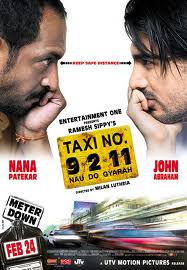 Ever saw a chess game played by amateurs…the way they try to make up their weak defence, by going for an early kill?
Ever saw a chess game played by amateurs…the way they try to make up their weak defence, by going for an early kill?
Amateaur chess players are weak in defence and ever keen to sweep the board clean. The option of a checkmate dawns on them, only when the board nears empty. They play for a kill and not for a win.
Taxi 9211 takes a similar format.
It tells the story of two characters who are blessed with a limited mental defence and a short fuse.
Jai Mittal(John Abraham) is the son of a rich guy, who just lost his golden goose(his father) and caught in the midst of a legal battle to acquire the eggs. Raghav Shastry(Nana Patekar) has never seen a golden egg..worst still, he has never heard of the story–The goose that laid golden eggs or The golden goose that laid eggs. Instead, he is out there on the streets as a taxi-driver and tries hard to steer through his mundane life.
John Abraham dresses in white, plays white and gets to make the first move.
Raghav Shastry (Nana Patekar) wears khaki and itches to take up the police work. He weilds his lathi, lashes his tongue and the game is on.
The game sets off with a bang(literally) on the bustling streets and escalates to a police station. The action reaches a crescendo when each of them occupy other’s turf–their homes.
Then the killing begins.
When both of them see enough of red, they strike an emotional chord and the game ends a draw, with both emerging as winners.
The movie takes a three act structure. The setting, the confrontation and the resolution.
The first two are decent, it is the third that takes a beating. Just as the confrontation heat is on, the movie rushes towards a climax.
So, what works for the movie? Novel canvass, Nana Patekar, Sanjay Dutt (the narrator) and the crisp editing.
What could have been better? Jai Mittal’s character, and the resolution.
Overall, the movie is worth a watch, and the Sippys should be congratulated for presenting a different fare.
One question that leaves you nagging at the end of the film–Why John Abraham? Was the budget so high (it does not appear so) that you needed star power for an assured box-office opening? And if John Abraham is a must, why not open the story with his character and unravel the other shades, not just burst out as they did, in the third act. Nana Patekar is world renowned for his throw-a-slap-in-the-face kind of roles. It is John Abraham, the star, who still needs to establish his image as an acto…so why deprive him of that chance and leave his character half-cooked.


